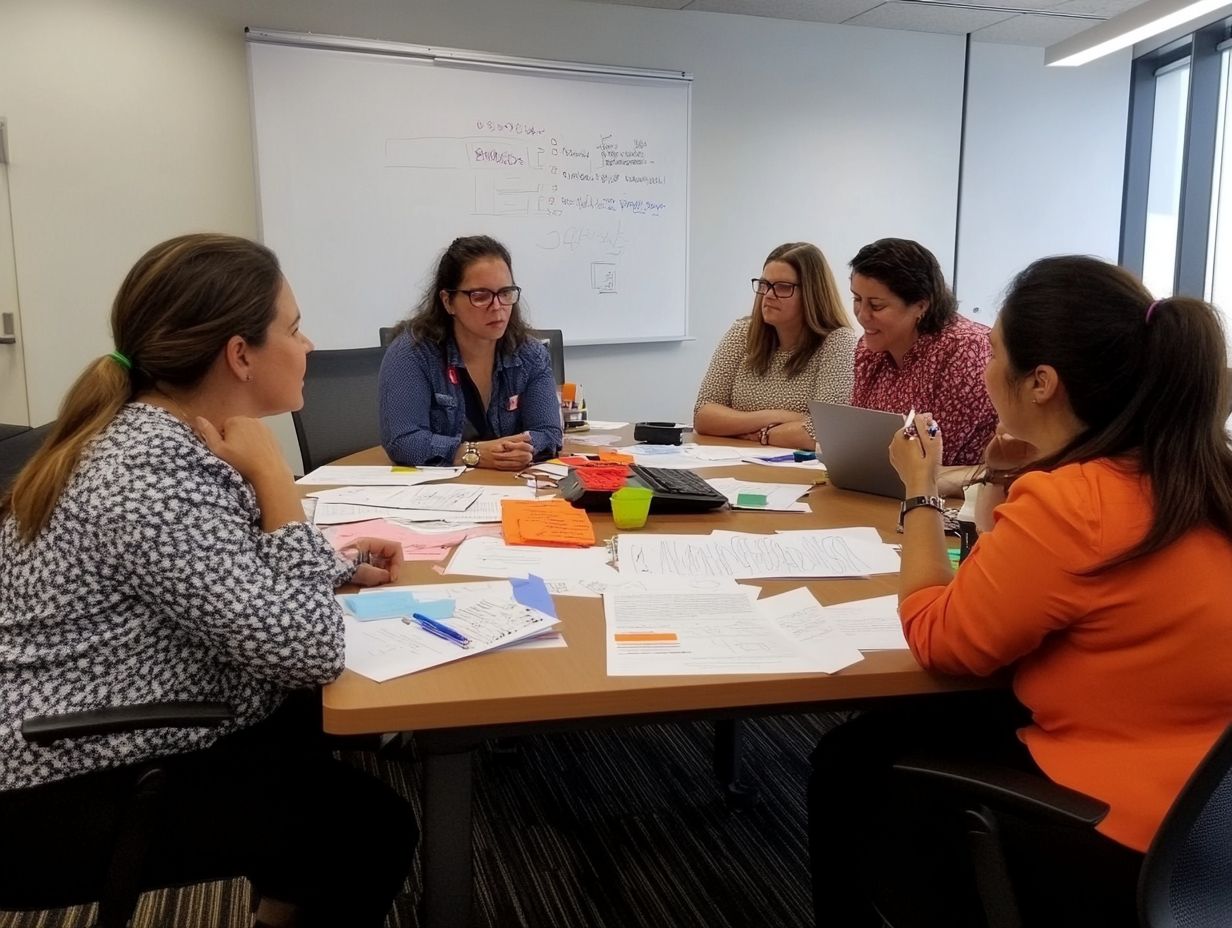The Basics of Licensing Agreements for Nonprofits
Licensing agreements can serve as a powerful asset for nonprofits. They present unique opportunities for revenue generation and expanding your organization’s reach.
It s essential to understand the various types of licensing agreements, such as exclusive versus non-exclusive and perpetual versus limited term. This knowledge enables you to make informed decisions that align with your goals.
This article explores the benefits of licensing for nonprofits. It highlights key elements to consider in the agreement and offers practical tips for negotiating and drafting terms that protect your organization’s interests.
Whether you re just beginning to explore this concept or looking to refine your current approach, this guide equips you with insights to navigate the licensing landscape with confidence.
Contents
- Key Takeaways:
- Understanding Licensing Agreements
- Types of Licensing Agreements
- Benefits of Licensing Agreements for Nonprofits
- Key Elements of a Licensing Agreement
- Negotiating and Drafting a Licensing Agreement
- Frequently Asked Questions
- What is a licensing agreement for nonprofits?
- What is the purpose of a licensing agreement for nonprofits?
- What are the key components of a licensing agreement for nonprofits?
- Do all nonprofits need licensing agreements?
- What are some common mistakes to avoid when creating a licensing agreement for nonprofits?
- Can a licensing agreement for nonprofits be modified or terminated?
Key Takeaways:

Licensing agreements are legal contracts that allow nonprofits to use, distribute, or sell their intellectual property in exchange for compensation. By entering into licensing agreements, nonprofits can generate revenue and expand their reach, while also protecting their intellectual property rights.
When negotiating and drafting a licensing agreement, nonprofits should carefully consider the terms and conditions, as well as important clauses such as termination and exclusivity.
Understanding Licensing Agreements
Licensing agreements are crucial legal contracts that define the terms under which a property owner, known as the licensor, gives specific rights to another party, the licensee, regarding the use of intellectual property.
These agreements play an essential role across various industries, from consumer electronics to media companies and nonprofit branding. They enable the authorized use of trademarks, copyrights, and patents, driving revenue generation and facilitating market expansion.
Definition and Purpose
A licensing agreement defines the specific rights you receive as a licensee from a licensor. It clearly outlines the obligations and responsibilities of both parties involved in the contract.
These agreements serve a range of purposes beyond simple permission. They allow you to use established trademarks or proprietary technologies, significantly enhancing your market reach.
Typically, they involve royalty payments, which are fees you pay to the owner based on how much you sell. This creates a mutually beneficial revenue stream.
Common scenarios for these agreements include:
- Product licensing in nonprofit branding initiatives, where charitable organizations partner with commercial enterprises to promote social causes.
- Managing trade secrets, ensuring that sensitive information is shared securely while protecting the interests of the original creators.
Types of Licensing Agreements
Licensing agreements come in several varieties, notably exclusive and non-exclusive agreements. Each type presents distinct levels of rights and limitations, tailored to specific geographical areas and defined time frames.
Understanding these nuances is essential for making informed decisions in your licensing endeavors.
Exclusive vs. Non-Exclusive
Exclusive licensing gives you sole rights to use the intellectual property. In contrast, non-exclusive licensing allows multiple parties to leverage the same property under shared terms.
Each arrangement has its implications for both you, the licensee, and the licensor. For example, an exclusive license can provide a competitive edge in the market without the threat of rival users invading your territory.
This level of control can lead to higher potential profits and more focused investment in your brand, similar to how Netflix secures exclusive streaming rights to popular shows.
However, keep in mind that the licensor might face limitations on revenue potential, as they cannot license the same property to others.
On the other hand, a non-exclusive arrangement, akin to McDonald’s franchising model, can enhance revenue streams for licensors by allowing multiple operators to capitalize on their branding simultaneously.
Yet, this approach can dilute your market share and diminish brand uniqueness if the product offerings become overly widespread.
Start exploring your licensing options today and watch your nonprofit thrive!
Perpetual vs. Limited Term

Perpetual licensing grants you ongoing rights without any expiration date. In contrast, limited term licensing designates a specific timeframe for those rights to be active.
This difference is very important for everyone involved. For instance, in the digital products realm, a software company might choose a limited term license. This allows for the renewal of subscription models or adaptation to the ever-changing technology landscape.
In the case of creative works, like an artist licensing their music, this agreement can secure usage rights for a promotional campaign. It may include termination conditions that stop royalties once the usage period is over.
On the flip side, a perpetual license offers stability and a long-term investment. Once granted, you retain access indefinitely. This means you can minimize future negotiations and focus on what truly matters.
Benefits of Licensing Agreements for Nonprofits
Licensing agreements offer numerous advantages for nonprofits. They allow you to generate significant licensing revenues, expand your reach, and build strategic partnerships that enhance your brand recognition and funding opportunities.
These agreements can be a powerful tool to elevate your organization’s impact and sustainability.
Generating Revenue and Expanding Reach
Through effective licensing agreements, you can generate revenue by collecting licensing fees for the use of your brand and creative works. This helps to expand your reach and impact.
By leveraging your unique brand identity, you can forge mutually beneficial partnerships with businesses that want to align themselves with causes that resonate with their audiences. This approach not only opens new revenue streams but also builds a community of supporters eager to promote your mission.
Consider a well-known environmental organization that capitalized on its logo through a partnership with a sustainable clothing line. This led to increased visibility and a significant surge in donations. Such success stories highlight the transformative potential of well-crafted licensing strategies that prioritize brand integrity while making a meaningful social impact.
Key Elements of a Licensing Agreement
A comprehensive licensing agreement should clearly outline essential elements, such as terms and conditions, ownership rights, payment details, quality standards, and usage terms.
This level of detail ensures clarity and fosters mutual understanding between you, the licensor, and the licensee.
Terms and Conditions
The terms and conditions section of your licensing agreement specifies how you may use the intellectual property. This includes essential provisions for breaches of contract and any damages that may arise.
By clearly defining these terms, you protect your interests while also safeguarding the other party s rights. This minimizes misunderstandings and potential legal disputes.
Consider media companies that license music for films. Without clear terms, they could find themselves in costly litigation if the music is misused or used beyond the agreed scope.
Similarly, nonprofit organizations working with vendors must ensure that conditions regarding the use of donated services are explicitly outlined. Failing to do so may lead to disputes over ownership and recognition, potentially harming relationships.
In both scenarios, having a strong terms and conditions framework fosters transparency, ultimately building trust and accountability among all parties involved.
Intellectual Property Rights

Intellectual property rights are essential to any licensing agreement, as they show who owns and controls copyrights, trademarks, patents, and trade secrets tied to the licensed material.
These rights not only safeguard the interests of creators but also clarify the legal responsibilities of the party giving the license (licensor) and the party receiving the license (licensee), ensuring that their use of intellectual property aligns with established standards.
OpenAI manages its copyrights and patents well, allowing others to use its innovations under specific terms.
Similarly, Dolby Laboratories, celebrated for its audio and visual technologies, leverages trademark protections to defend its brand while licensing various audio solutions to film studios and tech companies.
This intricate interplay of rights and regulations significantly shapes how you navigate contract management, ensuring compliance and fostering fruitful collaboration.
Negotiating and Drafting a Licensing Agreement
Negotiating and drafting a licensing agreement requires your careful attention to a range of factors. This includes employing effective negotiation strategies, identifying crucial clauses to incorporate, and performing a comprehensive risk assessment to safeguard the interests of both parties.
Tips for Successful Negotiations
Successful negotiations for a licensing agreement hinge on your ability to engage in strategic planning, communicate clearly, and grasp both the licensor’s obligations and the licensee’s rights.
To navigate this intricate landscape effectively, you need to employ key strategies that foster favorable outcomes for all parties involved. Flexibility is essential; it enables you to adapt to changing circumstances and unexpected challenges that may arise during discussions.
Active listening is equally important, as it allows you to fully understand the other party’s needs and concerns, creating a collaborative atmosphere. Your willingness to compromise can open doors to innovative solutions that cater to both sides’ interests.
A prime example can be found in the tech industry, where companies often achieve licensing agreements by creatively restructuring deal terms to align with each partner s objectives.
Important Clauses to Include
When drafting a licensing agreement, it’s essential for you to include key clauses such as termination conditions, confidentiality provisions, and mechanisms for dispute resolution. These elements are crucial for your success!
Think of these clauses as your roadmap, clarifying the rights and responsibilities of each party while helping to prevent misunderstandings that could spiral into costly disputes.
For example, having clearly defined termination conditions enables either party to exit the agreement under specific circumstances, cutting through any ambiguity that might arise.
Confidentiality clauses are equally important, as they shield sensitive information, ensuring that proprietary knowledge stays out of reach from competitors. This protection is crucial for maintaining your business s competitive edge.
Incorporating dispute resolution provisions lays out a clear strategy for addressing conflicts, saving you both time and resources in the long run.
Ignoring these clauses can lead to big problems, including legal challenges and financial losses. You must analyze contracts carefully to avoid potential pitfalls!
Frequently Asked Questions
What is a licensing agreement for nonprofits?

A licensing agreement for nonprofits is a legal agreement between a nonprofit organization and the owner of intellectual property, such as a trademark, copyright, or patent, that allows the nonprofit to use the property in exchange for a fee or other consideration.
What is the purpose of a licensing agreement for nonprofits?
The purpose of a licensing agreement for nonprofits is to allow the nonprofit to use the intellectual property of another party for a specific purpose, such as fundraising or promoting their cause, while also protecting the rights and interests of both parties.
What are the key components of a licensing agreement for nonprofits?
A licensing agreement for nonprofits should include the names and contact information of both parties. It also needs a detailed description of the licensed property, agreement duration, restrictions on use, payment terms, and termination clauses.
Do all nonprofits need licensing agreements?
No, not all nonprofits need licensing agreements. However, if a nonprofit plans to use someone else’s creative work, having a licensing agreement is essential to protect everyone s rights.
What are some common mistakes to avoid when creating a licensing agreement for nonprofits?
Common mistakes include failing to clearly define how the property will be used and not specifying the agreement s duration. Always ensure the agreement is reviewed by a legal professional.
Can a licensing agreement for nonprofits be modified or terminated?
Yes, a licensing agreement can be modified or terminated if both parties agree. It s vital to follow the outlined procedures to avoid legal issues.






